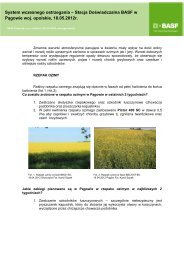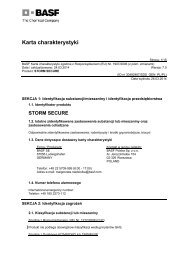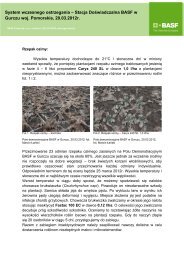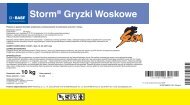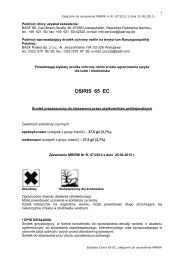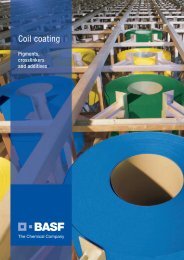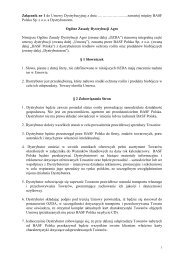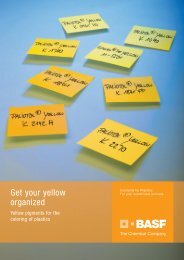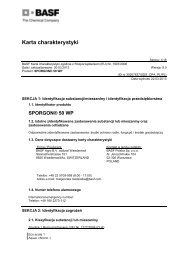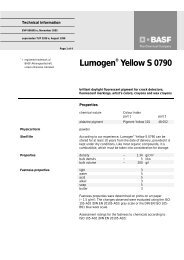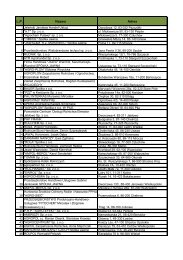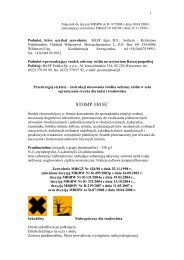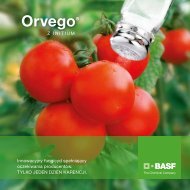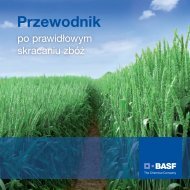Colorants
Colorants
Colorants
Create successful ePaper yourself
Turn your PDF publications into a flip-book with our unique Google optimized e-Paper software.
Technical Information<br />
EVP 008905 e, December 2005<br />
supersedes EVP 004005 e, April 2005<br />
Page 1 of 27<br />
®<br />
= registered trademark of<br />
BASF Aktiengesellschaft,<br />
unless otherwise indicated<br />
= trademark of BASF Aktiengesellschaft,<br />
unless otherwise indicated<br />
Range<br />
<strong>Colorants</strong><br />
for plastics colorations<br />
organic and inorganic pigments<br />
soluble dyestuffs<br />
Heliogen ®<br />
pigments<br />
Lithol ® pigments<br />
Paliogen ® pigments<br />
Paliotol ® pigments<br />
Sicomin ® pigments<br />
Sicopal ® pigments<br />
Sicotan ® pigments<br />
Sicotrans ® pigments<br />
Lumogen ® F dyes<br />
Thermoplast dyes<br />
Physical form powder or – for products suffixed “FG” – fine granules<br />
Storage According to the experience gained so far, the pigments and dyes<br />
listed in this Technical Information bulletin have, if stored cool and<br />
dry, a practically unlimited shelf life.<br />
Pigment preparations<br />
For certain plastics and applications it is often advantageous to use<br />
fully dispersed, low-dusting pigments – like Eupolen ®<br />
mono-pigment<br />
preparations – instead of pure pigments. This applies in particular to<br />
the coloration of very thin-walled products, when a very high degree<br />
of dispersion or dust-free conditions is required or when the pigments<br />
are to be metered automatically.<br />
Eupolen ®<br />
Eupolen ®<br />
Eupolen ®<br />
Euvinyl ®<br />
Oppasin ®<br />
PE preparations (powder, micro and standard pellets)<br />
PP preparations (standard pellets)<br />
PA preparations (standard pellets)<br />
C preparations (powder)<br />
preparations (chips)<br />
For more information please refer to the Technical Information bulletins,<br />
shade cards and brochures for the respective range.
EVP 008905 e, December 2005 Page 2 of 27 <strong>Colorants</strong> for plastic colorations<br />
General<br />
Aside from the field of application and the quality standard related<br />
to it, cost is an important issue when choosing a colorant. These<br />
criteria were taken into consideration when selecting the pigments<br />
to be listed in this Technical Information bulletin. These products<br />
meet medium to high standards of fastness to light, heat stability,<br />
fastness to migration and dispersibility.<br />
The letter “K” in a pigment’s name indicates that the product has<br />
been developed for the coloration of plastics and that the release<br />
inspection is carried out in plastics. Exceptions are:<br />
Lumogen ®<br />
F dyes photometric testing on a dye solution<br />
Thermoplast dyes photometric testing on a dye solution<br />
Tolerances are listed in the product specification sheets.<br />
<strong>Colorants</strong> can also be combined with additives like UV stabilizers,<br />
antistatic agents and antioxidants. For more information on BASF’s<br />
range of UV stabilizers, please refer to the Technical Information<br />
bulletin and the pocket reference Uvinul ®<br />
light stabilizers.<br />
You can find illustrations of the colorants in our pocket shade card<br />
Pigments for plastics (EVP 2405 DE).<br />
Technical literature Aside from the Technical Information bulletins and shade cards<br />
already mentioned, more are referred to within this document.<br />
Please contact our sales force to receive your copy. Shade cards<br />
and brochures can also be requested by e-mail from<br />
service.evp@basf-ag.de. Most documents are also available in the<br />
PDF file format on the Internet: www.basf.com/pigments.<br />
Quality management<br />
The production facilities for all products listed in this Technical Information<br />
bulletin are certified according to DIN EN ISO 9001, and<br />
so is the responsible operating division Performance Chemicals as<br />
a whole.<br />
Technical data<br />
Fastness to light The fastness to light is determined on injection-molded plaques of<br />
approximately 3 mm thickness. They are exposed to light according<br />
to DIN EN ISO 105-B 01 and assessed on the wool blue scale<br />
described in DIN EN ISO 105-B 01:
EVP 008905 e, December 2005 Page 3 of 27 <strong>Colorants</strong> for plastic colorations<br />
rating property<br />
1 very poor<br />
2 poor<br />
3 moderate<br />
4 fairly good<br />
5 good<br />
6 very good<br />
7 excellent<br />
8 outstanding<br />
Fastness to weathering Determined according to DIN EN ISO 4892-2 and assessed on the<br />
gray scale described in DIN EN 20105-A02.<br />
Heat stability The heat stability is determined according to DIN EN 12877-1 on a<br />
white reduction (organic pigments 1:10, inorganic pigments 1:4).<br />
The temperature of a PE-HD melt in an injection-molding machine<br />
is increased from 200 °C (392 °F) to 300 °C (592 °F) in steps of<br />
20 °C (68 °F) with a 5-minute dwell time. The heat stability denotes<br />
the highest temperature at which there is no noticeable change in<br />
shade (i. e., total color difference ΔE* is up to three units relative to<br />
the specimen prepared at 200 °C). Lumogen ®<br />
F and Thermoplast<br />
dyes are tested in different thermoplastics.<br />
Fastness to migration The fastness to migration is determined on a calendered PVC film<br />
in contact with a white-pigmented PVC film according to<br />
DIN 53775, part 3, at the pigment concentration indicated in the<br />
tables below. Other concentrations may result in different ratings.<br />
Ease of dispersion The ease of dispersion is determined following DIN EN 13900-2 in<br />
PVC-p, some pigments are tested in PE. The pigment is dispersed<br />
on a roll mill at 160 °C (320 °F). A part of the sheeted-out compound<br />
is allowed to cool to room temperature and then milled at<br />
130 °C (266 °F) again. The ease of dispersion is calculated from the<br />
increase of the relative color strength. The lower the value, the<br />
easier the pigment is to disperse.<br />
Bulk volume The bulk volume indicates the weight in grams of 1 cm³ of untamped<br />
material, determined according to DIN ISO 171.<br />
Density The density is determined according to DIN EN ISO 787-10 on a<br />
pyknometer.<br />
Suitability Please see the relevant tables for information on certain plastics.<br />
Suitability for<br />
food-contact applications<br />
Germany Recommendation IX of the Bundesinstitut<br />
für Risikobewertungen (Federal<br />
Institute for Risk Assessments, BfR,<br />
formerly BgVV), <strong>Colorants</strong> for the<br />
coloration of plastics and other poly-<br />
mers for materials and articles<br />
France Brochure No. 1227, French positive<br />
list
EVP 008905 e, December 2005 Page 4 of 27 <strong>Colorants</strong> for plastic colorations<br />
USA FDA, Title 21, Code of Federal Regulations,<br />
§ 178.3297, <strong>Colorants</strong> for polymers<br />
More information on application in food-contact articles and toys is<br />
available from our Technical Information bulletin Directives and<br />
regulations on the use of colorants in food-contact applications and<br />
toys and the data sheets on product safety for the individual<br />
products.
EVP 008905 e, December 2005 Page 5 of 27 <strong>Colorants</strong> for plastic colorations<br />
Heliogen ® pigments<br />
Range chemical nature<br />
Heliogen ®<br />
Heliogen ®<br />
Heliogen ®<br />
Heliogen ®<br />
Heliogen ®<br />
Heliogen ®<br />
Heliogen ®<br />
Heliogen ®<br />
Heliogen ®<br />
Heliogen ®<br />
Heliogen ®<br />
Properties<br />
Heliogen ®<br />
Heliogen ®<br />
Heliogen ®<br />
Heliogen ®<br />
Heliogen ®<br />
Heliogen ®<br />
Heliogen ®<br />
Heliogen ®<br />
Heliogen ®<br />
Heliogen ®<br />
Heliogen ®<br />
approved<br />
not approved<br />
Colour Index<br />
part 1 part 2<br />
Blue K 6850 Cu phthalocyanine, alpha unstable Pigment Blue 15 74 160<br />
Blue K 6902 Cu phthalocyanine, alpha stable Pigment Blue 15:1 74 160<br />
Blue K 6907 Cu phthalocyanine, alpha stable Pigment Blue 15:1 74 160<br />
Blue K 6911 D Cu phthalocyanine, alpha stable Pigment Blue 15:1 74 160<br />
Blue K 6911 FP Cu phthalocyanine, alpha stable Pigment Blue 15:1 74 160<br />
Blue K 7090 Cu phthalocyanine, beta Pigment Blue 15:3 74 160<br />
Blue K 7090 FP Cu phthalocyanine, beta Pigment Blue 15:3 74 160<br />
Blue K 7104 LW Cu phthalocyanine, beta Pigment Blue 15:4 74 160<br />
Green K 8730 Cu phthalocyanine Pigment Green 7 74 260<br />
Green K 8730 FP Cu phthalocyanine Pigment Green 7 74 260<br />
Green K 9360 Cu phthalocyanine Pigment Green 36 74 265<br />
heat<br />
resistance 1<br />
migration<br />
light<br />
suitability for<br />
fastness<br />
PE-HD<br />
full reduc full reduc<br />
shade tion shade tion<br />
0.2 % 1:10 0.2 % 1:10 0.2 %<br />
food-contact<br />
applications<br />
g/cm³ g/cm³ D F USA<br />
ease of<br />
dispersion<br />
Blue K 6850 200 200 8 8 5 < 10 1.6 0.40 <br />
Blue K 6902 300 300 8 8 5 15 1.6 0.32 <br />
Blue K 6907 300 300 8 8 5 < 10 1.6 0.32 <br />
Blue K 6911 D 300 300 8 8 5 < 10 1.6 0.33 <br />
Blue K 6911 FP 300 300 8 8 5 < 10 1.6 0.33 <br />
Blue K 7090 280 280 8 8 5 < 10 1.6 0.20 <br />
Blue K 7090 FP 280 280 8 8 5 < 10 1.6 0.20 <br />
Blue K 7104 LW 300 300 8 8 5 < 10 1.6 0.20 <br />
Green K 8730 320 300 8 8 5 < 10 2.1 0.30 <br />
Green K 8730 FP 320 300 8 8 5 < 10 2.1 0.30 <br />
Green K 9360 300 320 8 8 5 < 10 2.1 0.40 <br />
1 Celsius to Fahrenheit conversion: 200 °C = 392 °F, 280 °C = 536 °F, 300 °C = 592 °F, 320 °C = 608 °F<br />
density<br />
bulk density
EVP 008905 e, December 2005 Page 6 of 27 <strong>Colorants</strong> for plastic colorations<br />
Suitability<br />
PVC-p<br />
PVC-u<br />
PUR<br />
PE-LD<br />
Heliogen ® Blue K 6850 <br />
Heliogen ® Blue K 6902 <br />
Heliogen ® Blue K 6907 <br />
Heliogen ® Blue K 6911 D <br />
Heliogen ® Blue K 6911 FP <br />
Heliogen ® Blue K 7090 <br />
Heliogen ® Blue K 7090 FP <br />
Heliogen ® Blue K 7104 LW <br />
Heliogen ® Green K 8730 <br />
Heliogen ® Green K 8730 FP <br />
Heliogen ® Green K 9360 <br />
suitable<br />
limited suitability, preliminary tests required<br />
not suitable<br />
PE-HD<br />
PP<br />
PS<br />
SB<br />
SAN<br />
Their well-known good fastness properties make Heliogen ®<br />
pigments<br />
suitable for nearly all plastics and processing techniques.<br />
Coloristically, both the highly transparent hues and the shades<br />
achieved by combination with titanium dioxide or inorganic chromatic<br />
pigments are of great interest. In both cases, the fastnesses to<br />
weathering and light are outstanding. Even reductions with a high<br />
proportion or titanium dioxide still yield good fastness ratings.<br />
Heliogen ®<br />
pigments are stable to migration in all plastics, even in<br />
plasticized systems, at very low pigment concentration.<br />
Phthalocyanine green pigments may cause PE-HD to become brittle<br />
when extensively weathered outdoors. Therefore, preliminary<br />
suitability tests are necessary.<br />
The outstanding resistance to chemicals and the excellent thermal<br />
stability of Heliogen ®<br />
pigments open up a wide range of applications<br />
in the blue and green ranges, allowing application even in<br />
engineering plastics.<br />
In terms of hue, purity of shade and color strength combined,<br />
Heliogen ® Blue K 6907 is technically superior to all known alphamodified<br />
phthalocyanine blue pigments.<br />
Phthalocyanine pigments may cause warping in large injectionmolded<br />
PE-HD parts. An exception is Heliogen ® Blue K 7104 LW<br />
(LW = low warping) which practically shows no warping effect. For<br />
more information on this product, please refer to the brochure<br />
Heliogen ®<br />
Blue K 7104 LW – No warping, stable dimensions!.<br />
ABS/ASA<br />
PMMA<br />
PC<br />
PA<br />
PETP<br />
CA/CAB<br />
UP
EVP 008905 e, December 2005 Page 7 of 27 <strong>Colorants</strong> for plastic colorations<br />
Heliogen ® Blue K 6911 FP, Heliogen ® Blue K 7090 FP and Heliogen ®<br />
Green K 8730 FP are offered with a certified filter pressure value. For<br />
Heliogen ® Blue K 7090 FP and Heliogen ® Green K 8730 FP, the filter<br />
pressure value is guaranteed to be ≤ 1 bar/g, for Heliogen ®<br />
Blue<br />
K 6911 FP to be ≤ 2 bar/g. Thus these grades are particularly suited<br />
for the spin-dyeing of fibers. For more information, please refer to the<br />
brochure Color your fibers with warranty! – FP pigments with certified<br />
filter pressure value.
EVP 008905 e, December 2005 Page 8 of 27 <strong>Colorants</strong> for plastic colorations<br />
Lithol ® pigments<br />
Range chemical nature<br />
Lithol ®<br />
Lithol ®<br />
Properties<br />
Lithol ®<br />
Lithol ®<br />
Colour Index<br />
part 1 part 2<br />
Red K 3690 Naphthol red, Sr lake Pigment Red 53:3 15 585:3<br />
Scarlet K 4165 BON red 2B, Sr lake Pigment Red 48:3 15 865:3<br />
heat<br />
resistance 2<br />
migration<br />
light<br />
suitability for<br />
fastness<br />
PE-HD<br />
full reduc full reduc<br />
shade tion shade tion<br />
0.2 % 1:10 0.2 % 1:10 0.2 %<br />
food-contact<br />
applications<br />
g/cm³ g/cm³ D F USA<br />
ease of<br />
dispersion<br />
Red K 3690 240 240 4 2 4–5 < 10 1.7 0.33 <br />
Scarlet K 4165 240 260 6 4 4–5 < 10 1.8 0.15 <br />
approved<br />
no FDA approval, use only if “non-migration” can be demonstrated<br />
not approved<br />
Suitability<br />
Lithol ®<br />
Lithol ®<br />
PVC-p<br />
PVC-u<br />
PUR<br />
PE-LD<br />
Red K 3690 <br />
Scarlet K 4165 <br />
suitable<br />
limited suitability, preliminary tests required<br />
not suitable<br />
PE-HD<br />
PP<br />
PS<br />
SB<br />
Lithol ® pigments have outstanding fastness levels considering the<br />
price level. Typical fields of application are:<br />
films, particularly from PE-LD and PVC<br />
PVC cable sheathing and<br />
blow moldings, toys and simple injection moldings made from<br />
olefinic plastics<br />
They are not suitable for processing at higher temperatures or for<br />
the coloration of plastics for outdoor use when excellent fastness<br />
to light and weathering are required.<br />
In the applications mentioned, full-shade colorations yield good<br />
fastness ratings. Fastness levels are not as high in reductions with<br />
titanium dioxide. Particularly the fastness to light decreases as the<br />
titanium dioxide proportion increases.<br />
2 Celsius to Fahrenheit conversion: 200 °C = 392 °F, 280 °C = 536 °F, 300 °C = 592 °F, 320 °C = 608 °F<br />
SAN<br />
density<br />
ABS/ASA<br />
bulk density<br />
PMMA<br />
PC<br />
PA<br />
PETP<br />
CA/CAB<br />
UP
EVP 008905 e, December 2005 Page 9 of 27 <strong>Colorants</strong> for plastic colorations<br />
In principle, the fastness to migration of this pigment class is good.<br />
However, depending on the system used (e. g., PVC blends), migration<br />
cannot be ruled out. In critical applications like food packaging,<br />
preliminary trials should always be carried out.<br />
Lithol ® Scarlet K 4165 may adversely affect the heat resistance<br />
when alkalis are present.
EVP 008905 e, December 2005 Page 10 of 27 <strong>Colorants</strong> for plastic colorations<br />
Paliogen ® pigments<br />
Range chemical nature<br />
Paliogen ®<br />
Paliogen ®<br />
Paliogen ®<br />
Paliogen ®<br />
Properties<br />
Paliogen ®<br />
Paliogen ®<br />
Paliogen ®<br />
Paliogen ®<br />
approved<br />
not approved<br />
Suitability<br />
Colour Index<br />
part 1 part 2<br />
Red K 3580 perylene Pigment Red 149 71 137<br />
Red K 3911 HD perylene Pigment Red 178 71 155<br />
Red K 4180 perylene Pigment Red 179 71 130<br />
Red Violet K 5011 perylene Pigment Violet 29 71 129<br />
heat<br />
resistance 3<br />
migration<br />
light<br />
suitability for<br />
fastness<br />
PE-HD<br />
full reduc full reduc<br />
shade tion shade tion<br />
0.2 % 1:10 0.2 % 1:10 0.2 %<br />
food-contact<br />
applications<br />
g/cm³ g/cm³ D F USA<br />
ease of<br />
dispersion<br />
Red K 3580 260 280 8 7 4–5 < 10 1.4 0.23 <br />
Red K 3911 HD 300 300 8 7 4–5 < 10 1.6 0.22 <br />
Red K 4180 300 300 8 8 4–5 15 1.5 0.36 <br />
Red Violet K 5011 320 320 8 8 5 20 1.6 0.23 <br />
PVC-p<br />
PVC-u<br />
PUR<br />
PE-LD<br />
Paliogen ®<br />
Red K 3580 <br />
Paliogen ® Red K 3911 HD <br />
Paliogen ® Red K 4180 <br />
Paliogen ® Red Violet K 5011 <br />
suitable<br />
limited suitability, preliminary tests required<br />
Paliogen ®<br />
PE-HD<br />
PP<br />
PS<br />
SB<br />
SAN<br />
Red K 3580 and Paliogen ®<br />
Red K 3911 HD are top-quality<br />
products suitable for nearly all applications. They generally meet<br />
all demands in coloring engineering plastics.<br />
Paliogen ® Red K 3580 yields yellowish, transparent red shades with<br />
outstanding fastness ratings and is, among others, of interest in PP<br />
and PA spin-dyeing.<br />
Paliogen ® Red K 3911 HD is mostly used in near-full shades when<br />
good brilliance, good hiding power and very good fastnesses to<br />
light and weathering are required. Typical applications are bottle<br />
crates, automotive parts and brilliant red shades in ABS.<br />
3 Celsius to Fahrenheit conversion: 200 °C = 392 °F, 280 °C = 536 °F, 300 °C = 592 °F, 320 °C = 608 °F<br />
density<br />
ABS/ASA<br />
bulk density<br />
PMMA<br />
PC<br />
PA<br />
PETP<br />
CA/CAB<br />
UP
EVP 008905 e, December 2005 Page 11 of 27 <strong>Colorants</strong> for plastic colorations<br />
Paliogen ® Red K 4180 meets the highest demands of fastnesses to<br />
weathering and light. It is has both very good color strength and<br />
hiding power and can thus be used in combination with transparent<br />
and opaque pigments. In polyolefins, it is particularly stable to<br />
heat even in low concentrations. Paliogen ® Red K 4180 is widely<br />
used in spin-dyeing of PP and PA.<br />
Paliogen ® Red Violet K 5011 is a perylene distinguishing itself by its<br />
high color strength and high transparency. Fastness ratings are<br />
very good even in low concentrations. This makes it an extremely<br />
versatile pigment: it can be used in PVC for blending with inorganic<br />
pigments as well as in vivid shades in injection and blow molding<br />
as well as in PP and PA fibers both in full shade and as a shading<br />
pigment.
EVP 008905 e, December 2005 Page 12 of 27 <strong>Colorants</strong> for plastic colorations<br />
Paliotol ® pigments<br />
Range chemical nature<br />
Paliotol ®<br />
Paliotol ®<br />
Paliotol ®<br />
Paliotol ®<br />
Paliotol ®<br />
Paliotol ®<br />
Paliotol ®<br />
Properties<br />
Paliotol ®<br />
Paliotol ®<br />
Paliotol ®<br />
Paliotol ®<br />
Paliotol ®<br />
Paliotol ®<br />
Paliotol ®<br />
Colour Index<br />
part 1 part 2<br />
Yellow K 0961 HD quinophthalone Pigment Yellow 138 56 300<br />
Yellow K 1090 quinophthalone Pigment Yellow 138 56 300<br />
Yellow K 1700 azo, Na/Ca lake Pigment Yellow 183 4<br />
18 792 1<br />
Yellow K 1841 isoindoline Pigment Yellow 139 56 298<br />
Yellow K 1841 FP isoindoline Pigment Yellow 139 56 298<br />
Yellow K 2142 H isoindoline Pigment Yellow 139 56 298<br />
Yellow K 2270 azo, Ca lake Pigment Yellow 183 18 792<br />
heat<br />
resistance 5<br />
migration<br />
light<br />
suitability for<br />
fastness<br />
PE-HD<br />
full reduc full reduc<br />
shade tion shade tion<br />
0.2 % 1:10 0.2 % 1:10 0.2 %<br />
food-contact<br />
applications<br />
g/cm³ g/cm³ D F USA<br />
ease of<br />
dispersion<br />
Yellow K 0961 HD 280 270 8 7 4–5 < 10 1.8 0.4 <br />
Yellow K 1090 280 260 8 6 5 < 10 1.8 0.3 <br />
Yellow K 1700 300 280 7 3 5 < 10 1.7 0.1 <br />
Yellow K 1841 240 240 8 7 4–5 < 10 1.6 0.3 <br />
Yellow K 1841 FP 240 240 8 7 4–5 < 10 1.6 0.3 <br />
Yellow K 2142 H 240 260 8 7 5 < 10 1.7 0.3 <br />
Yellow K 2270 290 300 8 5 5 < 10 1.8 0.4 <br />
approved<br />
not approved<br />
Suitability<br />
PVC-p<br />
PVC-u<br />
PUR<br />
PE-LD<br />
Paliotol ®<br />
Yellow K 0961 HD <br />
Paliotol ®<br />
Yellow K 1090 <br />
Paliotol ®<br />
Yellow K 1700 <br />
Paliotol ® Yellow K 1841 <br />
Paliotol ® Yellow K 1841 FP <br />
Paliotol ® Yellow K 2142 H <br />
Paliotol ® Yellow K 2270 <br />
suitable<br />
limited suitability, preliminary tests required<br />
not suitable<br />
4 similar<br />
5 Celsius to Fahrenheit conversion: 200 °C = 392 °F, 280 °C = 536 °F, 300 °C = 592 °F, 320 °C = 608 °F<br />
PE-HD<br />
PP<br />
PS<br />
SB<br />
SAN<br />
density<br />
ABS/ASA<br />
bulk density<br />
PMMA<br />
PC<br />
PA<br />
PETP<br />
CA/CAB<br />
UP
EVP 008905 e, December 2005 Page 13 of 27 <strong>Colorants</strong> for plastic colorations<br />
Paliotol ® pigments are organic pigments with outstanding fastness<br />
ratings in a variety of plastics.<br />
Paliotol ® Yellow K 0961 HD must be tested for suitability and resistance<br />
to both heat and chemicals when used in engineering<br />
plastics.<br />
Paliotol ® Yellow K 1700 and Paliotol ® Yellow K 2270 are very resistant<br />
to heat and chemicals. They are mainly used for the coloration<br />
of PP and engineering plastics like ABS.<br />
Paliotol ® Yellow K 1841, Paliotol ® Yellow K 1841 FP and Paliotol ®<br />
Yellow K 2142 H, based on isoindoline, are mainly used in all technologies<br />
of polyolefin (PE-LD, PE-HD, PP) coloration. They are also<br />
well suitable for application in PVC-p and PVC-u.<br />
Their chemical structure makes Paliotol ® Yellow K 1841, Paliotol ®<br />
Yellow K 1841 FP and Paliotol ®<br />
Yellow K 2142 H sensitive to alkalis<br />
(Ca and Zn stearates in PE-HD and PP). Good fastness to light and<br />
a relatively good heat resistance make them suitable for, in particular,<br />
the coloration of polyolefin films, tapes and fibers.<br />
Paliotol ®<br />
Yellow K 1841 FP is offered with a certified filter pressure<br />
value. The filter pressure value is guaranteed to be ≤ 1 bar/g. Thus<br />
this grade is particularly suited for the spin-dyeing of PP fibers. For<br />
more information, please refer to the brochure Color your fibers with<br />
warranty! – FP pigments with certified filter pressure value.<br />
Paliotol ®<br />
Yellow K 2142 H is an opaque and very reddish variant of<br />
Pigment Yellow 139 (isoindoline) and extends the Paliotol ®<br />
yellows<br />
into orange. Compared with Paliotol ® Yellow K 1841 or Paliotol ®<br />
Yellow K 1841 FP, it has coarser particles and thus is more reddish<br />
and weaker, but has superior fastness properties (fastness to light,<br />
heat stability). Its hiding power and color strength are distinctly<br />
better than that of isoindolinone pigments, making it a cost-effective<br />
alternative for the application in polyolefin films and injection<br />
molding as well as in PVC.<br />
All products from the isoindoline range (Paliotol ® Yellow K 1841,<br />
Paliotol ® Yellow K 1841 FP and Paliotol ® Yellow K 2142 H) are lowwarping<br />
in PE-HD and can be used in the respective applications.
EVP 008905 e, December 2005 Page 14 of 27 <strong>Colorants</strong> for plastic colorations<br />
Sicomin ® pigments<br />
Range chemical nature<br />
Sicomin ®<br />
Sicomin ®<br />
Sicomin ®<br />
Sicomin ®<br />
Sicomin ®<br />
Sicomin ®<br />
Sicomin ®<br />
Properties<br />
Sicomin ®<br />
Sicomin ®<br />
Sicomin ®<br />
Sicomin ®<br />
Sicomin ®<br />
Sicomin ®<br />
Sicomin ®<br />
not approved<br />
Suitability<br />
Colour Index<br />
part 1 part 2<br />
Yellow K 1625 lead chromate Pigment Yellow 34 77 603<br />
Yellow K 1630 S lead chromate Pigment Yellow 34 77 603<br />
Yellow K 1922 lead chromate Pigment Yellow 34 77 603<br />
Yellow K 1925 lead chromate Pigment Yellow 34 77 603<br />
Red K 3023 lead chromate/lead molybdate Pigment Red 104 77 605<br />
Red K 3030 S lead chromate/lead molybdate Pigment Red 104 77 605<br />
Red K 3130 S lead chromate/lead molybdate Pigment Red 104 77 605<br />
heat<br />
resistance 6<br />
migration<br />
light<br />
suitability for<br />
fastness<br />
PE-HD<br />
full reduc full reduc<br />
shade tion shade tion<br />
1.0% 1:4 1.0% 1:4 0.4 %<br />
food-contact<br />
applications<br />
g/cm³ g/cm³ D F USA<br />
ease of<br />
dispersion<br />
Yellow K 1625 250 280 8 8 5 < 10 5.5 0.6 <br />
Yellow K 1630 S 250 280 8 8 5 < 10 5.3 0.6 <br />
Yellow K 1922 220 220 7 8 5 < 10 5.6 0.7 <br />
Yellow K 1925 240 260 8 8 5 < 10 5.8 0.7 <br />
Red K 3023 260 280 8 8 5 < 10 6.0 0.9 <br />
Red K 3030 S 260 280 8 8 5 < 10 6.0 0.9 <br />
Red K 3130 S 260 280 8 8 5 < 10 5.7 1.1 <br />
PVC-p<br />
PVC-u<br />
PUR<br />
PE-LD<br />
Sicomin ®<br />
Yellow K 1625 <br />
Sicomin ®<br />
Yellow K 1630 S <br />
Sicomin ®<br />
Yellow K 1922 <br />
Sicomin ®<br />
Yellow K 1925 <br />
Sicomin ® Red K 3023 <br />
Sicomin ® Red K 3030 S <br />
Sicomin ® Red K 3130 S <br />
suitable<br />
limited suitability, preliminary tests required<br />
not suitable<br />
6 Celsius to Fahrenheit conversion: 200 °C = 392 °F, 280 °C = 536 °F, 300 °C = 592 °F, 320 °C = 608 °F<br />
PE-HD<br />
PP<br />
PS<br />
SB<br />
SAN<br />
density<br />
ABS/ASA<br />
bulk density<br />
PMMA<br />
PC<br />
PA<br />
PETP<br />
CA/CAB<br />
UP
EVP 008905 e, December 2005 Page 15 of 27 <strong>Colorants</strong> for plastic colorations<br />
Sicomin ® pigments are solid solutions of lead chromate/lead sulfate<br />
(yellow) or lead chromate/lead molybdate/lead sulfate (red) with very<br />
good to outstanding fastness ratings. Grades suffixed by an “S“ are<br />
resistant to sulfur dioxide.<br />
They are particularly suitable the coloration of PVC for a variety of<br />
applications such as calendar films, floor coverings, profiles, tubings,<br />
sheets and cable sheathings. Their advantage is a low pigmentation<br />
cost.<br />
For the coloration of PE and PS, Sicomin ® pigments are resistant to<br />
temperatures of 240C/464F or 260C/500F.<br />
Sicomin ® pigments are lead-chromate pigments subject to hazard<br />
labeling and in almost all countries, their use is limited. Please refer<br />
to the Data sheet on product safety and the material safety data<br />
sheet of the relevant pigment.
EVP 008905 e, December 2005 Page 16 of 27 <strong>Colorants</strong> for plastic colorations<br />
Sicopal ® pigments<br />
Range chemical nature<br />
Sicopal ®<br />
Sicopal ®<br />
Sicopal ®<br />
Sicopal ®<br />
Sicopal ®<br />
Sicopal ®<br />
Sicopal ®<br />
Sicopal ®<br />
Sicopal ®<br />
Sicopal ®<br />
Sicopal ®<br />
Properties<br />
Sicopal ®<br />
Sicopal ®<br />
Sicopal ®<br />
Sicopal ®<br />
Sicopal ®<br />
Sicopal ®<br />
Sicopal ®<br />
Sicopal ®<br />
Sicopal ®<br />
Sicopal ®<br />
Sicopal ®<br />
Colour Index<br />
part 1 part 2<br />
Black 0090 Fe/Cr/Co oxide Pigment Black 27 77 502<br />
Yellow K 1120 FG bismuth vanadate Pigment Yellow 184 77 1740<br />
Yellow K 1160 FG bismuth vanadate Pigment Yellow 184 77 1740<br />
Brown K 2595 Zn/Fe oxide Pigment Yellow 119 77 496<br />
Brown K 2795 Fe/Cr oxide Pigment Brown 29 77 500<br />
Blue K 6210 Co/Al oxide Pigment Blue 28 77 346<br />
Blue K 6310 Co/Al oxide Pigment Blue 28 77 346<br />
Blue K 6710 Co/Al/Cr oxide Pigment Blue 36 77 343<br />
Blue K 7210 Co/Al/Cr oxide Pigment Blue 36 77 343<br />
Green K 9610 Co/Ti/Ni/Zn oxide Pigment Green 50 77 377<br />
Green K 9710 Co/Ti/Ni/Zn oxide Pigment Green 50 77 377<br />
heat<br />
resistance 7<br />
migration<br />
light<br />
suitability for<br />
fastness<br />
PE-HD<br />
full reduc full reduc<br />
shade tion shade tion<br />
1.0% 1:4 1.0% 1:4 0.4 %<br />
food-contact<br />
applications<br />
g/cm³ g/cm³ D F USA<br />
ease of<br />
dispersion<br />
Black 0090 300 320 8 8 5 < 10 4.9 1.0 <br />
Yellow K 1120 FG 250 270 8 8 5 < 10 4.1 0.8 <br />
Yellow K 1160 FG 270 290 8 8 5 < 10 4.1 0.8 <br />
Brown K 2595 320 320 8 8 5 < 10 5.3 0.7 <br />
Brown K 2795 320 320 8 8 5 < 10 5.2 0.5 <br />
Blue K 6210 300 320 8 8 5 < 10 4.0 0.5 <br />
Blue K 6310 320 320 8 8 5 < 10 4.5 0.4 <br />
Blue K 6710 320 320 8 8 5 < 10 4.5 0.6 <br />
Blue K 7210 320 320 8 8 5 < 10 4.5 0.5 <br />
Green K 9610 320 320 8 8 5 < 10 4.9 0.9 <br />
Green K 9710 320 320 8 8 5 < 10 4.8 0.7 <br />
approved<br />
no FDA approval, use only if “non-migration” can be demonstrated<br />
not approved<br />
7 Celsius to Fahrenheit conversion: 200 °C = 392 °F, 280 °C = 536 °F, 300 °C = 592 °F, 320 °C = 608 °F<br />
density<br />
bulk density
EVP 008905 e, December 2005 Page 17 of 27 <strong>Colorants</strong> for plastic colorations<br />
Suitability<br />
PVC-p<br />
PVC-u<br />
PUR<br />
PE-LD<br />
Sicopal ® Black 0090 <br />
Sicopal ® Yellow K 1120 FG <br />
Sicopal ® Yellow K 1160 FG <br />
Sicopal ® Brown K 2595 <br />
Sicopal ® Brown K 2795 <br />
Sicopal ® Blue K 6210 <br />
Sicopal ® Blue K 6310 <br />
Sicopal ® Blue K 6710 <br />
Sicopal ® Blue K 7210 <br />
Sicopal ® Green K 9610 <br />
Sicopal ® Green K 9710 <br />
suitable<br />
limited suitability, preliminary tests required<br />
PE-HD<br />
PP<br />
PS<br />
SB<br />
With the exception of the bismuth vanadate pigments Sicopal ®<br />
Yellow K 1120 FG and Sicopal ®<br />
Yellow K 1160 FG, Sicopal ®<br />
pigments<br />
are spinel-structured metal oxides. Their very good heat resistance<br />
makes them suitable for the coloration of nearly all<br />
plastics.<br />
Sicopal ®<br />
pigments cause no warpage in injection-molded or extruded<br />
parts – not even large ones. This and their outstanding fastness<br />
to weathering make them perfectly suitable for bottle crates.<br />
Sicopal ®<br />
SAN<br />
Yellow K 1120 FG is a low-dusting fine granule bismuth<br />
vanadate pigment with excellent color strength and heat resistance.<br />
Sicopal ®<br />
Yellow K 1160 FG is not only suitable for polyolefins<br />
and ABS (thermo stability of 270–290 °C [518–544 °F]) but for<br />
PA injection molding as well (280–300 °C [536–572 °F]). Their outstanding<br />
fastness to weathering make them particularly suitable for<br />
outdoor applications (bottle crates, garden furniture, garbage cans)<br />
as a substitute to lead- or cadmium-based pigments.<br />
Sicopal ® Brown K 2595 and Sicopal ® Brown K 2795 are outstandingly<br />
fast to weathering in outdoor applications when stabilized<br />
suitably (dibasic lead phosphite). Both a balanced recipe and easy<br />
processing are essential. Due to the many established PVC stabilization<br />
systems based on calcium/zinc or certain tin compounds,<br />
we recommend suitability tests under customer-specific processing<br />
parameters.<br />
ABS/ASA<br />
PMMA<br />
PC<br />
PA<br />
PETP<br />
CA/CAB<br />
UP
EVP 008905 e, December 2005 Page 18 of 27 <strong>Colorants</strong> for plastic colorations<br />
Sicotan ® pigments<br />
Range chemical nature<br />
Sicotan ®<br />
Sicotan ®<br />
Sicotan ®<br />
Sicotan ®<br />
Sicotan ®<br />
Sicotan ®<br />
Sicotan ®<br />
Sicotan ®<br />
Sicotan ®<br />
Sicotan ®<br />
Sicotan ®<br />
Sicotan ®<br />
Sicotan ®<br />
Sicotan ®<br />
Sicotan ®<br />
Properties<br />
Sicotan ®<br />
Sicotan ®<br />
Sicotan ®<br />
Sicotan ®<br />
Sicotan ®<br />
Sicotan ®<br />
Sicotan ®<br />
Sicotan ®<br />
Sicotan ®<br />
Sicotan ®<br />
Sicotan ®<br />
Sicotan ®<br />
Sicotan ®<br />
Sicotan ®<br />
Sicotan ®<br />
Colour Index<br />
part 1 part 2<br />
Yellow K 1010 Ni/Sb/Ti oxide Pigment Yellow 53 77 788<br />
Yellow K 1010 FG Ni/Sb/Ti oxide Pigment Yellow 53 77 788<br />
Yellow K 1011 Ni/Sb/Ti oxide Pigment Yellow 53 77 788<br />
Yellow K 1011 FG Ni/Sb/Ti oxide Pigment Yellow 53 77 788<br />
Yellow K 2001 Cr/Sb/Ti oxide Pigment Brown 24 77 310<br />
Yellow K 2001 FG Cr/Sb/Ti oxide Pigment Brown 24 77 310<br />
Yellow K 2011 Cr/Sb/Ti oxide Pigment Brown 24 77 310<br />
Yellow K 2011 FG Cr/Sb/Ti oxide Pigment Brown 24 77 310<br />
Yellow K 2111 Cr/Sb/Ti oxide Pigment Brown 24 77 310<br />
Yellow K 2111 FG Cr/Sb/Ti oxide Pigment Brown 24 77 310<br />
Yellow K 2112 Cr/Sb/Ti oxide Pigment Brown 24 77 310<br />
Yellow K 2112 FG Cr/Sb/Ti oxide Pigment Brown 24 77 310<br />
Brown K 2611 Mn/Sb/Ti oxide Pigment Yellow 164 77 899<br />
Brown K 2711 Mn/Sb/Ti oxide Pigment Yellow 164 77 899<br />
Brown K 2750 FG Mn/Sb/Ti oxide Pigment Yellow 164 77 899<br />
heat<br />
resistance 8<br />
migration<br />
light<br />
suitability for<br />
fastness<br />
PE-HD<br />
full reduc full reduc<br />
shade tion shade tion<br />
1.0% 1:4 1.0% 1:4 0.4 %<br />
food-contact<br />
applications<br />
g/cm³ g/cm³ D F USA<br />
ease of<br />
dispersion<br />
Yellow K 1010 320 320 8 8 5 < 10 4.5 0.9 <br />
Yellow K 1010 FG 320 320 8 8 5 < 10 4.5 0.9 <br />
Yellow K 1011 320 320 8 8 5 < 10 4.4 0.8 <br />
Yellow K 1011 FG 320 320 8 8 5 < 10 4.4 0.8 <br />
Yellow K 2001 320 320 8 8 5 < 10 4.5 0.6 <br />
Yellow K 2001 FG 320 320 8 8 5 < 10 4.5 0.6 <br />
Yellow K 2011 320 320 8 8 5 < 10 4.5 0.7 <br />
Yellow K 2011 FG 320 320 8 8 5 < 10 4.5 0.7 <br />
Yellow K 2111 320 320 8 8 5 < 10 4.4 0.8 <br />
Yellow K 2111 FG 320 320 8 8 5 < 10 4.4 0.8 <br />
Yellow K 2112 320 320 8 8 5 < 10 4.4 0.9 <br />
Yellow K 2112 FG 320 320 8 8 5 < 10 4.4 0.9 <br />
Brown K 2611 320 320 8 8 5 < 10 4.3 0.9 <br />
Brown K 2711 320 320 8 8 5 < 10 4.8 0.9 <br />
Brown K 2750 FG 320 320 8 8 5 < 10 4.8 0.9 <br />
approved<br />
no FDA approval, use only if “non-migration” can be demonstrated<br />
not approved<br />
8 Celsius to Fahrenheit conversion: 200 °C = 392 °F, 280 °C = 536 °F, 300 °C = 592 °F, 320 °C = 608 °F<br />
density<br />
bulk density
EVP 008905 e, December 2005 Page 19 of 27 <strong>Colorants</strong> for plastic colorations<br />
Suitability<br />
PVC-p<br />
PVC-u<br />
PUR<br />
PE-LD<br />
Sicotan ® Yellow K 1010 <br />
Sicotan ® Yellow K 1010 FG <br />
Sicotan ® Yellow K 1011 <br />
Sicotan ® Yellow K 1011 FG <br />
Sicotan ® Yellow K 2001 <br />
Sicotan ® Yellow K 2001 FG <br />
Sicotan ® Yellow K 2011 <br />
Sicotan ® Yellow K 2011 FG <br />
Sicotan ® Yellow K 2111 <br />
Sicotan ® Yellow K 2111 FG <br />
Sicotan ® Yellow K 2112 <br />
Sicotan ® Yellow K 2112 FG <br />
Sicotan ®<br />
Brown K 2611 <br />
Sicotan ®<br />
Brown K 2711 <br />
Sicotan ®<br />
Brown K 2750 FG <br />
suitable<br />
PE-HD<br />
PP<br />
PS<br />
SB<br />
Their outstanding fastness ratings make Sicotan ®<br />
pigments ideally<br />
suitable for plastics resistant to both weathering and heat, in particular<br />
for beige and brown shades as well as for shading.<br />
SAN<br />
ABS/ASA<br />
PMMA<br />
PC<br />
PA<br />
PETP<br />
CA/CAB<br />
UP
EVP 008905 e, December 2005 Page 20 of 27 <strong>Colorants</strong> for plastic colorations<br />
Sicotrans ® pigments<br />
Range chemical nature<br />
Sicotrans ®<br />
Sicotrans ®<br />
Properties<br />
Sicotrans ®<br />
Sicotrans ®<br />
approved<br />
Suitability<br />
Sicotrans ®<br />
Sicotrans ®<br />
suitable<br />
not suitable<br />
Colour Index<br />
part 1 part 2<br />
Red K 2819 iron[III] oxide Pigment Red 101 77 491<br />
Red K 2915 iron[III] oxide Pigment Red 101 77 491<br />
heat<br />
resistance 9<br />
migration<br />
light<br />
suitability for<br />
fastness<br />
PE-HD<br />
full reduc full reduc<br />
shade tion shade tion<br />
1.0% 1:4 1.0% 1:4 0.4 %<br />
food-contact<br />
applications<br />
g/cm³ g/cm³ D F USA<br />
ease of<br />
dispersion<br />
Red K 2819 300 300 8 8 5 < 10 4.4 0.3 <br />
Red K 2915 320 320 8 8 5 < 10 5.1 0.5 <br />
PVC-p<br />
PVC-u<br />
PUR<br />
PE-LD<br />
PE-HD<br />
Red K 2819 <br />
Red K 2915 <br />
PP<br />
PS<br />
SB<br />
Sicotrans ® Red K 2819 and Sicotrans ® Red K 2915 are iron oxides<br />
with an extremely small particle size.<br />
Sicotrans ® Red K 2819 yields highly transparent colorations with<br />
UV-absorbing properties. Sicotrans ® Red K 2915 allows semitransparent<br />
full-shade colorations with high chroma to be<br />
achieved.<br />
SAN<br />
density<br />
ABS/ASA<br />
bulk density<br />
PMMA<br />
PC<br />
PA<br />
The iron content may cause catalytic degradation in PVC.<br />
9 Celsius to Fahrenheit conversion: 200 °C = 392 °F, 280 °C = 536 °F, 300 °C = 592 °F, 320 °C = 608 °F<br />
PETP<br />
CA/CAB<br />
UP
EVP 008905 e, December 2005 Page 21 of 27 <strong>Colorants</strong> for plastic colorations<br />
Lumogen ® F dyes<br />
Range chemical nature<br />
Lumogen ®<br />
Lumogen ®<br />
Lumogen ®<br />
Lumogen ®<br />
Lumogen ®<br />
Lumogen ®<br />
Lumogen ®<br />
Properties<br />
Lumogen ®<br />
Lumogen ®<br />
Lumogen ®<br />
Lumogen ®<br />
Lumogen ®<br />
Lumogen ®<br />
Lumogen ®<br />
F Yellow 083 perylene<br />
F Yellow 170 perylene<br />
F Orange 240 perylene<br />
F Pink 285 perylene<br />
F Red 305 perylene<br />
F Violet 570 naphthalimide<br />
F Blue 650 naphthalimide<br />
suitability for food-<br />
yield<br />
contact<br />
applications<br />
PC 0.02 % λ in CH Cl max. 2 2 quantum<br />
g/cm³ g/cm³ °C nm nm % D F USA<br />
density<br />
bulk density<br />
heat<br />
resistance 10<br />
light<br />
fastness<br />
F Yellow 083 1,3 0.25 300 8 476 490 > 85 <br />
F Yellow 170 1,3 0,10 300 8 505 528 > 90 <br />
F Orange 240 1,4 0.20 300 8 524 539 > 90 <br />
F Pink 285 1,3 0.20 300 8 547 580 > 78 <br />
F Red 305 1,4 0.22 300 8 578 613 > 90 <br />
F Violet 570 1,3 0.22 300 5 378 413 > 85 <br />
F Blue 650 1,3 0.22 300 7 377 411 > 80 <br />
approved<br />
no FDA approval, use only if “non-migration” can be demonstrated<br />
not approved<br />
Solubility<br />
acetone<br />
benzyl alcohol<br />
butyl acetate 100 %<br />
Lumogen ® F Yellow 083 0.5 1.0 0.2 3.0 < 0.1 0.2 < 0.1 1.0 < 0.5 < 0.1 < 1.0 0.5<br />
Lumogen ® F Orange 240 2.0 3.0 < 0.5 15.0 < 1.0 < 0.5 < 0.5 2.0 2.0 < 0.5 < 2.0 < 1.0<br />
Lumogen ® F Red 305 10.0 30.0 30.0 70.0 < 1.0 20.0 < 1.0 5.0 10.0 < 1.0 80.0 30.0<br />
Lumogen ® F Violet 570 5.0 30.0 5.0 7.0 < 1.0 1.0 < 0.5 3.0 4.0 < 0.5 10.0 15.0<br />
Lumogen ® F Blue 650 6.0 30.0 5.0 8.0 < 1.0 1.0 < 0.5 4.0 5.0 < 0.5 12.0 18.0<br />
10 Celsius to Fahrenheit conversion: 300 °C = 572 °F<br />
dimethyl formamide<br />
ethanol 99.5 %<br />
absorption<br />
ethyl acetate<br />
emission<br />
isopropanol<br />
methyl methacrylate<br />
Solvenon ® PM<br />
white spirit<br />
toluene<br />
xylene
EVP 008905 e, December 2005 Page 22 of 27 <strong>Colorants</strong> for plastic colorations<br />
Suitability<br />
PVC-p<br />
PVC-u<br />
PUR<br />
PE-LD<br />
Lumogen ® F Yellow 083 <br />
Lumogen ® F Yellow 170 <br />
Lumogen ® F Orange 240 <br />
Lumogen ® G Pink 285 <br />
Lumogen ® F Red 305 <br />
Lumogen ® F Violet 570 <br />
Lumogen ® F Blue 650 <br />
suitable<br />
limited suitability, preliminary tests required<br />
not suitable<br />
PE-HD<br />
PP<br />
PS<br />
SB<br />
SAN<br />
The Lumogen ®<br />
F range comprises high-purity fluorescent dyes of<br />
polycyclic nature. They show a very brilliant fluorescence and have<br />
outstanding fastness properties.<br />
Fastness to weathering Specimen: injection-molded PMMA plaques, 2 mm thick, colored<br />
with 0.02 % dye; test condition and criteria: Xenotest ®11<br />
1200 accelerated<br />
weathering according to DIN EN ISO 4892-2; remaining<br />
fluorescence (%) after 2,000 hours of exposure<br />
Lumogen ®<br />
Lumogen ®<br />
Lumogen ®<br />
Lumogen ®<br />
Lumogen ®<br />
ABS/ASA<br />
ABS<br />
PMMA<br />
PC<br />
PBT<br />
PA<br />
F Yellow 083 > 90<br />
F Orange 240 > 85<br />
F Red 305 > 95<br />
F Violet 570 > 80 after 1,500 hours<br />
F Blue 650 > 80 after 1,500 hours<br />
The best-suited carrier material for Lumogen ®<br />
F dyes is PMMA if<br />
outdoor application is intended. Foreign substances contained in<br />
PMMA may decrease the fastness to weathering.<br />
Sheets made by casting from monomeric MMA usually contain<br />
small proportions of monomer and reaction initiator. In tests such<br />
material has shown to impair the resistance of weathering. When<br />
casting sheets, the temperature during curing must be checked<br />
carefully to fully avoid residues of monomers. This problem will not<br />
arise when PMMA thermo-forming material is used.<br />
In outdoor weathering, a decrease of fluorescence during summer<br />
has shown to recuperate to almost its original level during the<br />
darker winter season.<br />
11 registered trademark of Xenotest Gesellschaft für die Herstellung von Materialprüfgeräten mbH<br />
PETP<br />
CA/CAB<br />
UP
EVP 008905 e, December 2005 Page 23 of 27 <strong>Colorants</strong> for plastic colorations<br />
Application<br />
The ability of fluorescent dyes to emit absorbed light at different<br />
wavelengths can be used to collect light. The fluorescent collector<br />
consists of a crystal-clear plastic sheet colored with a fluorescent<br />
dye. Within the sheet, total reflectance will divert fluorescent radiation<br />
to the borders of the sheet, from where the largest share is focused<br />
and emitted. Unlike systems of mirrors and lenses, the<br />
fluorescent collector will also concentrate diffused, undirected light.<br />
Use of the fluorescent collector is manifold:<br />
solar energy<br />
photo voltaics – by mounting solar cells to the edges of the collector,<br />
sufficient energy to operate small devices like watches, pocket<br />
computers, electrical displays, radios, recharging devices etc. can<br />
be produced.<br />
light engineering<br />
indirect illumination, fluorescence conversion, markings and warning<br />
devices, e. g., for road traffic (these are particularly effective in<br />
bad weather and at dawn), safety clothing, optical fibers for technical<br />
appliances<br />
advertising/design<br />
information signs, sports and leisure articles, toys, substitutes for<br />
luminescent tubes<br />
For these applications, fluorescent dyes must meet very high<br />
requirements:<br />
excellent fastness properties in certain polymers<br />
high luminance<br />
extremely high chroma<br />
good solubility in plastics<br />
high heat stability<br />
Lumogen ®<br />
F dyes meet these requirements to a great extent and<br />
conform to the specifications of the fluorescent collector.<br />
Lumogen ® F dyes can be used with all crystal-clear polymers.<br />
Migration or bleeding must be expected with polymers containing<br />
butadiene or plasticizers or in semi-crystalline polymers. Pre-trials<br />
are strongly recommended for these applications.<br />
Processing The dyestuff powder is distributed among the polymer powder, grit<br />
or granules in slow or quick mixers. Generally, the dyestuff powder<br />
will adhere to the polymer by electrostatic charge. Prior to further<br />
processing the mixture should be homogenized on an extruder.<br />
Dosage The concentration of dyestuff required depends on the thickness of<br />
the part to be colored. Normally, very low dosages of between<br />
0.005 % and 0.02 % will suffice.
EVP 008905 e, December 2005 Page 24 of 27 <strong>Colorants</strong> for plastic colorations<br />
Thermoplast dyes<br />
Range chemical nature<br />
Colour Index<br />
part 1 part 2<br />
Thermoplast Black X 70 blend – –<br />
Thermoplast F Yellow 084 perylene Solvent Green 5 59 075<br />
Thermoplast Yellow 104 pyrazolone Solvent Yellow 93 48 160<br />
Thermoplast Red 454 monoazo Solvent Red 195 –<br />
Thermoplast Blue 670 anthraquinone Solvent Blue 35 61 554<br />
Thermoplast Blue 684 anthraquinone Solvent Violet 13 60 725<br />
Properties<br />
density bulk suitability for<br />
density food-contact applications<br />
g/cm³ g/cm³ D F USA<br />
Thermoplast Black X 70 1.4 0.30 <br />
Thermoplast F Yellow 084 1.3 0.42 <br />
Thermoplast Yellow 104 1.3 0.50 <br />
Thermoplast Red 454 1.3 0.16 <br />
Thermoplast Blue 670 1.1 0.30 <br />
Thermoplast Blue 684 1.4 0.35 <br />
approved<br />
no FDA approval, use only if “non-migration” can be demonstrated<br />
not approved<br />
heat resistance 12 at 1/3 SDS 13<br />
at 2 % TiO 2<br />
PS SAN PMMA PC ABS ASA SB<br />
Thermoplast Black X 70 300 240 280 320 230 220 260<br />
Thermoplast F Yellow 084 260 300 300 310 300 300 300<br />
Thermoplast Yellow 104 300 240 280 300 240 240 260<br />
Thermoplast Red 454 280 280 300 300 260 260 280<br />
Thermoplast Blue 670 280 280 300 300 260 240 260<br />
Thermoplast Blue 684 300 300 300 340 270 280 300<br />
fastness to light at 1/3 SDS 15<br />
PS SAN PMMA PC ABS ASA SB PVC-u<br />
Thermoplast Black X 70 5 5–6 6 6 4–5 4–5 3–4 7<br />
Thermoplast F Yellow 084 3 3 4 3–4 4 3 4 4d<br />
Thermoplast Yellow 104 8 8 7 8 6 6–7 7 7–8<br />
Thermoplast Red 454 7 7 7 7 5–6 5–6 7 6<br />
Thermoplast Blue 670 7 7 7 7 6 6 7 8<br />
Thermoplast Blue 684 5 5 6 6–7 4–5 5–6 5 6–7<br />
12 Celsius to Fahrenheit conversion: 220 °C = 428 °F, 230 °C = 446 °F, 240 °C = 464 °F, 260 °C = 500 °F, 270 °C = 518 °F,<br />
280 °C = 536 °F, 300 °C = 572 °F, 310 °C = 590 °F, 320 °C = 608 °F, 340 °C = 644 °F<br />
13 opaque coloration at 1/3 standard depth of shade
EVP 008905 e, December 2005 Page 25 of 27 <strong>Colorants</strong> for plastic colorations<br />
Fastness to weathering at 1/3 SDS 15 PS SAN PMMA PC ABS ASA SB PVC-u<br />
Thermoplast Black X 70 3 3–4 4 3–4 2–3 3–4 3 2<br />
Thermoplast F Yellow 084 1–2 1–2 1–2 1 2 2 2 2d<br />
Thermoplast Yellow 104 4–5 4 5 5 3 4 4 4–5<br />
Thermoplast Red 454 4–5 4–5 4–5 3 2 2–3 4 5<br />
Thermoplast Blue 670 4–5 4–5 4–5 3 2 2–3 4 5<br />
Thermoplast Blue 684 3 3–4 4 3–4 3 3–4 3 4<br />
d = darkens when exposed to light<br />
Suitability<br />
PVC-p<br />
PVC-u<br />
PUR<br />
PE-LD<br />
Thermoplast Black X 70 <br />
Thermoplast F Yellow 084 <br />
Thermoplast Yellow 104 <br />
Thermoplast Red 454 <br />
Thermoplast Blue 670 <br />
Thermoplast Blue 684 <br />
suitable<br />
limited suitability, preliminary tests required<br />
not suitable<br />
PE-HD<br />
PP<br />
PS<br />
SB<br />
SAN<br />
The essential characteristic in terms of application for all Thermoplast<br />
dyes is their solubility in almost all amorphous polymers and<br />
polymer melts.<br />
The dyes distinguish themselves by high color strength and subsequent<br />
efficiency. They result in pure vivid shades. They can be<br />
mixed freely with one another or with organic or inorganic pigments.<br />
Each and every desired hue may be attained. For opaque<br />
colorations a scattering white or chromatic pigment is added.<br />
Application Sometimes, the shade of a coloration is influenced by the opacity<br />
or the inherent color of a polymer. A shade in standard polystyrene<br />
may be different from that in polycarbonate. Important factors are<br />
the solubility characteristics of the dye and any chemical interactions<br />
between the dye and the polymer.<br />
The solvatochromy (solubilized chromatic substances display different<br />
color hues in media of different polarity) plays an important role.<br />
To ensure optimum fluorescence when transparent plastics are colored<br />
with Thermoplast F Yellow 084, attention must be paid to the<br />
concentration of the dye and the thickness of the finished article.<br />
Maximum fluorescence is attained at a concentration of approx.<br />
0.01 % Thermoplast F Yellow 084 in specimens of 2 mm thickness<br />
and at approx. 0.05 % in 0.2 mm specimens. Excessive amounts of<br />
dye quench the fluorescence.<br />
ABS/ASA<br />
ABS<br />
PMMA<br />
PC<br />
PA<br />
PETP<br />
CA/CAB<br />
UP
EVP 008905 e, December 2005 Page 26 of 27 <strong>Colorants</strong> for plastic colorations<br />
Thermoplastics based on cellulose, such as cellulose acetate (CA)<br />
and cellulose acetobutyrate (CAB), can also be colored with soluble<br />
dyes. However, the fastness to migration of the intended coloration<br />
should first be tested.<br />
Dyes are not recommended for coloring polyethylene, polypropylene<br />
and especially PVC that contains plasticizer, because in these<br />
cases migration can be expected to occur. These plastics are colored<br />
almost exclusively with pigments.<br />
Note that dyes can alter the curing time of colored thermoset plastics<br />
such as unsaturated polyesters (UP).<br />
Coloration is carried out in two steps:<br />
The dry dyestuff powder is evenly distributed on the plastic<br />
powder, grit or granules in slow or quick mixers. Generally,<br />
the dyestuff will adhere to the plastic’s surface by<br />
electrostatic charging.<br />
When mixing relatively large proportions of dyestuff with<br />
plastic pellets, it may be necessary to prewet the pellets with<br />
an adhesion agent (low-viscous, neutral media such as<br />
Adhesion Agent W 1700). The proportion required must be<br />
determined empirically, adding 0.1 % to 0.3 % relative to the<br />
polymer are usually sufficient.<br />
Better distribution of the dye is achieved by first producing a<br />
“concentrate” which is then brought to the desired<br />
concentration in the same mixing vessel:<br />
fill about ¼ of the vessel with the polymer<br />
add the adhesion agent<br />
add the dyestuff<br />
mix<br />
add remaining polymer<br />
mix<br />
Preferably, the mixing vessel should be of uncoated metal to avoid<br />
undesired electrostatic charging of the vessel wall.<br />
Adhesion Agent W 1700 will avoid electrostatic charging so mixing<br />
can be done in PE-HD drums to prevent metal abrasion.
EVP 008905 e, December 2005 Page 27 of 27 <strong>Colorants</strong> for plastic colorations<br />
Safety<br />
When handling these products, advice and information given in the<br />
safety data sheet must be complied with. Further, protective and<br />
workplace hygiene measures adequate for handling chemicals<br />
must be observed.<br />
Note<br />
The data contained in this publication are based on our current<br />
knowledge and experience. In view of the many factors that may<br />
affect processing and application of our product, these data do not<br />
relieve processors from carrying out their own investigations and<br />
tests; neither do these data imply any guarantee of certain properties,<br />
nor the suitability of the product for a specific purpose. Any<br />
descriptions, drawings, photographs, data, proportions, weights,<br />
etc. given herein may change without prior information and do not<br />
constitute the agreed contractual quality of the product. It is the<br />
responsibility of the recipient of our products to ensure that any<br />
proprietary rights and existing laws and legislation are observed.<br />
BASF Aktiengesellschaft<br />
Performance Chemicals for<br />
Coatings, Plastics and Specialties<br />
67056 Ludwigshafen, Germany<br />
www.basf.com/pigments<br />
www.basf.com/resins<br />
www.basf.com/lightstableizers



